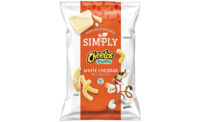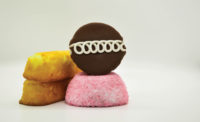Snack cakes have always been popular, partially due to the fact that they’re so portable—pop one in your purse or in the car, and you’ve got an “on-the-go” snack. The category continues to grow, with different flavors and trends emerging each year.
Overview | Bread | Tortillas | Sweet Goods | Snack Cakes | Pizza | Desserts | Cookies | Buns & Rolls | Bars | Breakfast Products
Market data
For the 52 weeks ending March 24, 2019, per data from IRI, Chicago, the bakery snacks category remained relatively flat, declining 0.6 percent to $3.4 billion in sales. McKee Foods leads the category, up 1.1 percent to $841.6 million. Grupo Bimbo saw nice growth of 13.7 percent to $252.6 million.
Table Talk Pies made a nice entrance to the top 10 companies in the category with 55.7 percent growth of its snack-sized pie products to $34.6 million.
Looking back
“Time scarcity and busy lifestyles are the primary forces behind the growing snack trends, but the increasing demand for premiumization and indulgence is also driving growth for snack cakes,” says Walden Hodges, senior business development manager, sweet goods, Corbion, Lenexa, KS.
Hodges says that research from Innova Market Insights shows that the average American now spends less than 30 minutes a day eating. “We’ve found this to be especially true for younger consumers like millennials, who say they’re simply too busy to sit down and enjoy a meal or to be bothered with cooking or baking. As a result, many consumers are opting for bite-sized products that satisfy their cravings on the go—and snack cakes fit the bill,” he explains.
Premiumization also helps give consumers a reason to indulge, because food is so accessible nowadays, Hodges continues. As a result, mini, bite-sized and smaller-portioned bakery items that deliver a premium, fresh-quality experience are finding new ways into consumers’ baskets.
“In general, premiumization typically signals better quality or a higher degree of value that motivates consumers to indulge in a product they want, like snack cakes,” Hodges says.
Hodges also says that like many other avenues of the food industry, he is seeing demand for more transparency with snack cakes. “Consumers are looking for products made without artificial flavors or colors. In order to appeal to more customers, many bakers are taking steps to be more open and transparent with customers regarding what goes into their snack cakes and other sweet goods.”
Courtney Schumacher, senior marketing specialist, Kerry, Beloit, WI, notes that clean label will continue to evolve and grow as it relates to snack cakes. “Currently, clean label for snack cakes is all around the removal of ‘unfriendly’ ingredients like artificial colors/flavors, high-fructose corn syrup and PHOs, as well as the addition of ‘real’ ingredients like real chocolate or vanilla,” she says. “With the success of recent ‘cleaner label’ sweet snack options, I think we’ll see the clean-label snack cake category expand to the removal of additional unfriendly ingredients like artificial preservatives.”
Back in 2017, Otis Spunkmeyer—an ARYZTA brand—removed all artificial flavors, colors, partially hydrogenated oils (PHOs) and high-fructose corn syrup from its products, including bakery snacks like Cinnamon Crumb Loaf Cake and Iced Lemon Loaf Cake.
Taste is also a huge market driver across the food industry, especially when it comes to sweet goods, says Schumacher. “Consumers are no longer content with the standard chocolate, vanilla or strawberry flavor offers and are looking for more flavor variety and innovation. According to Mintel, 72 percent of consumers who eat prepared sweet goods would like to see greater flavor variety. In the snack cake category, we see brands responding to this with extra-indulgent flavors or innovative LTOs.”
Drake’s released its Christmas Mint Creme Devil Dogs as a holiday LTO in October 2018. The company got the flavor idea by polling its fans.
The Flowers Foods brand Tastykake is known for its seasonal offerings. Its winter 2018/2019 snacks included a Chocolate Mint Pie, and its Easter 2019 snacks include Hippity Hops (cakes with coconut filling), Tasty Tweets (iced crème-filled chocolate cakes with sprinkles), Bunny Treats (iced yellow cakes with sprinkles), and Snowballs (coconut and marshmallow covered chocolate cakes with crème filling).
In February 2019, Hostess also released a few spins on its traditional CupCake: Birthday CupCakes, Mint Chocolate CupCakes, and Strawberry CupCakes.
Janelle Crawford, strategic marketing lead, DuPont Nutrition & Health, Wilmington, DE, notes that limited edition and/or seasonal products continue to be popular methods to promote snack cake products in the market. “Cobranding and unique flavors have been additional ways companies use to provide ‘new news’ in a mature industry,” she says.
From a formulation perspective, one of the biggest requests DuPont receives is to help manufacturers maintain the freshness of the product throughout an extended shelf life, Crawford adds. “This can allow companies to reach new geographic areas with minimal investment and allows for the exploration of different distribution models.”
Another current trend is versatility, says Daniele Bianchini, foodservice marketing director, Otis Spunkmeyer, Los Angeles. “Unlike some other snack foods consumers crave, loaf cakes can be enjoyed throughout the day—they are great to snack on between meals, but can also be used for a meal replacement, like breakfast. It’s these kinds of versatile foods that today, more than ever, consumers are looking for in the snack cake category,” she says.
Looking forward
“Better-for-you has always been on trend when it comes to loaf cakes, and I think we’ll continue to see this shape the industry in the coming year, because consumers are always on the hunt for an indulgent treat made with better ingredients,” notes Bianchini. When Otis Spunkmeyer launched its Grab N’ Go loaf cakes, the snacks were made without artificial flavors, colors, high-fructose corn syrup or PHOs for that reason.
“While we’re providing an indulgence, we want consumers to feel good about the ingredients used to make these snacks,” says Bianchini.
Shelf life extension will remain a key trend shaping the future of the snack cake category, says Crawford. Manufacturers continue to push freshness boundaries, and suppliers are working to deliver effective solutions that delay staling, mold and oxidation over time.
Working with knowledgeable suppliers is key to getting an effective solution for each brand—and product’s unique needs, Crawford notes. “For example, many ingredients can help delay staling in baked goods. But what type, format and dosage of enzymes, emulsifiers and/or hydrocolloids is optimal? And with what antimicrobial and antioxidant packages to maintain all aspects of freshness throughout shelf life? A total ingredient solution developed to work in combination with processing variables can impact a company’s ability to win in such a challenging landscape,” she says.
“And because the market is mature, I expect to see brands explore new ways to differentiate their products and to satisfy consumers’ desire for indulgence in their diets,” adds Crawford.
As technology evolves, Crawford also expects that innovation can come in the form of new and innovative packaging solutions, whether that’s to help extend shelf life, support portion control and convenience, reduce waste, or deliver against other cost reduction or consumer-driven needs in the market.
“While competition within the category is high—between branded products, as well as among branded vs. in-store baked goods—packaged snack cakes can also compete with other items that meet the need for convenient, on-the-go breakfast and snacking occasions, such as bars, RTD beverages, dairy products, fresh fruits/veggies, fast food channels, etc. These challenges will not subside, so it’s important that brands understand and cater to their target market to gain share and deliver growth going forward,” says Crawford.
Hodges says that he’s already seeing a lot of experimentation with premium packaging to help draw in a wider range of consumers. “Consumers relish the opportunity to consume the highest-quality products, including baked goods, and packaging plays a big role in premiumization. Many packaged goods manufacturers are also experimenting with flavors and unique forms of packaging to help keep products fresher for longer, no matter when or where the products are consumed,” he says.
Corbion offers several solutions to help protect the quality and consistency of finished products, including its Ultra Fresh Sweet enzyme solutions, which offer several days of extended freshness for in-store bakery products, and up to 45 days of extended freshness for packaged back goods. It also offers SweetPro solutions, which help bakers ensure quality and consistency, especially when it comes to reformulation for sweet baked goods.
“Moving forward, we anticipate seeing bolder flavors added to the snack cakes category,” continues Hodges. “There are significant opportunities for taste and flavor innovation, including unique seasonal varieties and combinations.” Flavors that trigger seasonal and holiday memories, such as pumpkin spice and key lime, incite fond emotions from childhood and are popular in LTOs, he explains.
“Indulgent, sugary flavors like cereal milk, s’mores, birthday cake and cookie dough are especially popular, because they are visually appealing and give consumers an enjoyable moment of reminiscence,” Hodges says.
When it comes to loaf cakes, using simple, subtle ingredients—like lemon and cinnamon—have a better response than other flavor profiles, suggests Bianchini. “Because snack cakes are so versatile, incorporating subtle flavors to round out the snack cake has led to a better customer response. Our Grab N’ Go Iced Lemon Loaf Cakes and Cinnamon Loaf Cakes have performed well in c-stores, in large part because of the specific ingredients we used for those foods,” she explains.
Additionally, there has been a significant shift in purchase behaviors when buying snack cakes due to greater availability of products, convenience and distribution opportunities, notes Hodges. “Now, consumers have more options than just going to a corner bakery. As bakery manufacturers continue to implement new technologies and solutions that help maintain the quality and consistency of their products, we will likely see more consumers choosing between in-store bakery items and packaged snack cakes,” he says.
Taste innovation and clean label will both continue to shape the snack cake category over the coming year, says Schumacher. Removing unfriendly ingredients like artificial preservatives will likely come first. “Looking further out, we’ll also see brands start to react to the consumer demand around proactive health in nontraditional categories like snack cakes,” she suggests. “The definition of what each means to the snack cake category will evolve with the changing consumer demands.”
Overview | Bread | Tortillas | Sweet Goods | Snack Cakes | Pizza | Desserts | Cookies | Buns & Rolls | Bars | Breakfast Products









